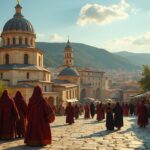
How did Byzantine culture and religion spread in Eastern Europe
Just how Byzantine culture and religion subtly transformed Eastern Europe reveals a fascinating blend of faith, politics, and innovation that shaped history.

For the Olmec and Maya, religion wasn’t just belief—it was the foundation of life itself. From sacred sites and offerings to cosmic calendars and rituals, faith shaped how these civilizations understood power, community, and the universe.
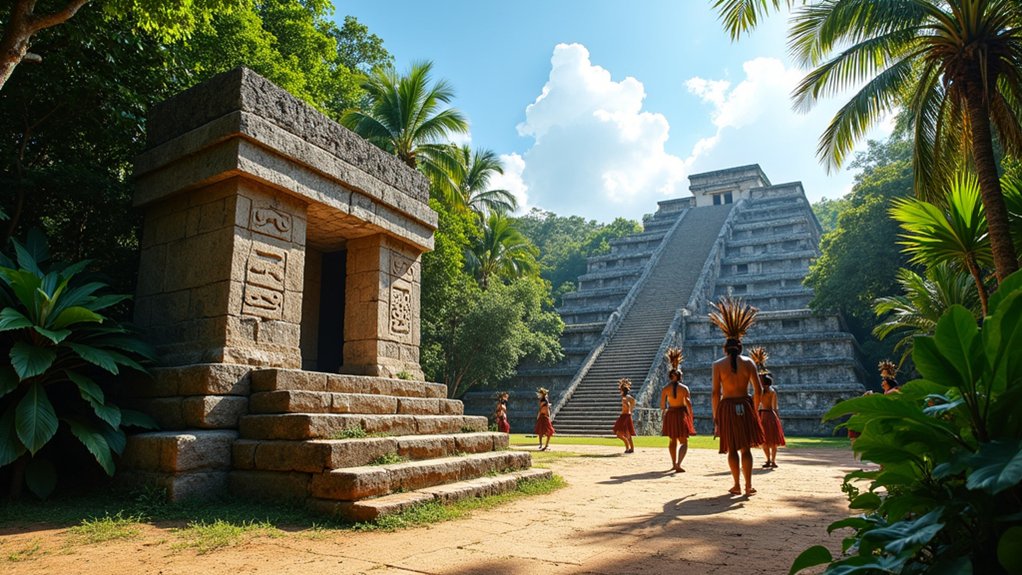
But what role did religion truly play in their world—and how did it guide the way they lived and ruled?
Let’s explore.
The religious beliefs and cosmology of the Olmec reveal a deep connection between nature, sacred beings, and the spirit world. In Olmec religion, the cosmos was shaped by powerful deities and ancestral spirits, guiding creation and the balance of life.
The Olmec underworld and afterlife played a central role in this worldview, acting as spiritual realms where transformation and renewal occurred.
Rituals, offerings, and symbolic art were key expressions of Olmec spirituality. Through ceremonies, shamans and community leaders sought guidance from Olmec deities, honoring the cycles of life, death, and rebirth.
This strong spiritual tradition helped the Olmec understand cosmic order and maintain harmony between the earth, the heavens, and the Olmec underworld.
Deities and spiritual figures in Olmec culture played a vital role in religion and spirituality, connecting people with nature and the cosmos.
In Olmec culture, deities embodied natural forces like rain, fertility, and earth, while spiritual figures represented ancestral wisdom and protection.
Archaeological artifacts show rich spiritual symbolism, revealing how Olmec culture blended myth, ritual, and cosmic beliefs.
Through ceremonies, offerings, and sacred spaces, these figures shaped community life and expressed a deep spiritual worldview.
Ultimately, Olmec culture shows how religion, spirituality, and ancestral traditions worked together to guide daily life and ritual practice.
Olmec religious rituals and ceremonies were powerful expressions of faith, designed to honor deities and strengthen ties with ancestral spirits.
These sacred practices took place at ceremonial centers, where offerings, dances, and processions were performed as part of larger Olmec religious festivals.
Through Olmec religious rituals, communities practiced ancestor worship, sought divine favor, and reinforced social unity and spiritual authority, showing how deeply religion shaped Olmec daily life and cultural identity.
Olmec symbolism reveals a deep connection between religion, spirituality, and the natural world. Sacred animals like jaguars appear throughout Olmec art as powerful symbols of divine energy, bridging humans and supernatural forces.
This rich visual language reflects the core of Olmec religion, expressing beliefs about the cosmos, transformation, and sacred power. Through these motifs, the Olmec used spirituality to strengthen cultural identity and share a unified worldview.
Political power and religion in Olmec society were deeply connected, shaping both leadership and daily life. Rulers used sacred symbols and rituals to project authority, showing how religion could legitimize political decisions.
This blend of politics and spirituality created a form of divine kingship, where leaders claimed religious authority to guide the community. Through sacred governance, power was maintained, social order was reinforced, and the role of religion in Olmec society remained central.
The Maya religious worldview shaped every part of daily life, guiding art, politics, and community values. At the heart of Maya religious worldview were creation myths, Underworld mythology, and a sense of divine dualism that balanced life and death, light and shadow.
Sacred animals and celestial beings symbolized cosmic cycles, while ancestor worship and tales of mythical heroes connected the living to the divine and preserved cultural wisdom.
Through rituals, offerings, and storytelling, the Maya religious worldview offered meaning, order, and a spiritual path that resonated across generations.
Priests and shamans in Maya culture played a vital role in religion and spirituality, acting as bridges between the human and divine worlds.
In Maya religion, the priestly hierarchy organized rituals, maintained sacred calendars, and interpreted holy texts to guide community life.
Shamans practiced trance work and healing ceremonies to communicate with spirits, offering protection and insight.
Together, priests and shamans sustained spiritual balance, shaped religious practices, and reinforced social order—key pillars of Maya spirituality and religious tradition.
Religious architecture in Maya culture was a powerful expression of their spirituality and worldview. The temples and pyramids of the Maya were designed as sacred spaces where religion guided daily life, shaping rituals, governance, and community identity.
These monumental structures symbolized sacred mountains connecting earth and sky, reflecting a deep belief in the layered cosmos central to Maya religion.
Mayan pyramid construction also showcased advanced engineering, with precise alignment to celestial events that supported spiritual practices and ceremonial calendars.
As centers of worship, offerings, and communication with deities, Maya temples embodied the unity of religion, leadership, and society—revealing how spirituality shaped both the architecture and the heart of Maya civilization.
Ceremonial practices in Maya culture played a crucial role in religion and spirituality, helping maintain cosmic order and social harmony.
Maya bloodletting was a key ritual that symbolized sacrifice and communication with the gods, reflecting deep spiritual beliefs.
Ceremonial ballgames also held spiritual significance, while sacred cenotes were seen as portals to the divine.
Through divine offerings, communities honored their deities to ensure balance, protection, and favor.
These traditions show how Maya religion and spirituality shaped daily life, guided communal values, and connected people to the sacred world.
Maya hieroglyphs played a vital role in religion and spirituality, acting as a sacred script for recording beliefs, ceremonies, and divine stories.
In Maya religious texts, hieroglyphs preserved myths, rituals, and the names of gods, ensuring that spiritual knowledge could be passed down accurately.
By using hieroglyphs in sacred inscriptions, Maya priests and scribes safeguarded core teachings of their religion, strengthening community faith and keeping spiritual traditions alive.
Astronomy and calendars played a vital role in Maya religion, shaping both daily life and sacred traditions.
In Maya religion, priests used careful celestial observations to guide ritual timekeeping and agricultural planning, aligning ceremonies with lunar cycles and the solar year.
Eclipses, solstices, and planetary movements were seen as divine messages, and in Maya religion these events reinforced the bond between the cosmos, spirituality, and community rituals.
Religion profoundly shaped the social hierarchy of the Maya civilization.
In Maya society, religion guided daily life, state decisions, and spiritual duties, placing priests and rulers at the top because of their sacred roles. This religious hierarchy legitimized political power and maintained order, as spiritual leaders mediated between gods and people, influencing governance, social roles, and community cohesion.
Through rituals, ceremonies, and divine authority, religion strengthened social stratification while uniting communities under shared beliefs and spiritual practices.
The social and political life of the Maya was closely tied to their religion and spirituality, shaping daily life, leadership, and ceremony. Early Olmec influence introduced key religious ideas, and Maya culture adapted them into complex rituals, sacred calendars, and temple practices.
Through ongoing religious syncretism, these beliefs survived colonial change and continue today, preserving a shared spiritual heritage and guiding modern indigenous identities across Mesoamerica.
This enduring legacy shows how religion and spirituality can anchor community, memory, and meaning across generations.
Religion fundamentally shaped both Olmec and Maya cultures, guiding spirituality, governance, and daily life. In Olmec culture, religion connected people to nature, ancestors, and cosmic forces through rituals, sacred sites, and symbolic art, reinforcing community identity and political authority. In Maya civilization, religion organized time and society through myths, calendars, and hieroglyphs, aligning agricultural cycles with spiritual ceremonies and priestly leadership. Together, these traditions show how religion and spirituality fostered harmony, balance, and a sacred bond between humans and the cosmos, leaving a lasting spiritual legacy in Mesoamerican history.

Just how Byzantine culture and religion subtly transformed Eastern Europe reveals a fascinating blend of faith, politics, and innovation that shaped history.
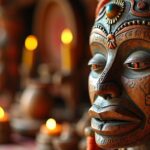
Bridging the seen and unseen, African art reveals deeper spiritual meanings—discover how creativity becomes a sacred dialogue in these cultures.
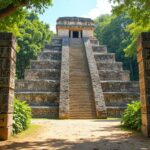
Linking sacred numbers to celestial events, the Maya intertwined math and religion in ways that still mystify scholars today. Discover their profound connection.
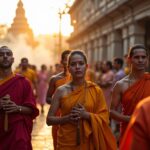
Only by examining religion can we grasp the deep values shaping cultures—discover how belief systems influence identity and social cohesion.
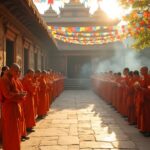
The transformative impact of culture on Buddhist practices reveals unexpected variations that challenge traditional interpretations and invite deeper exploration.
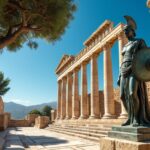
Journey into how religion and mythology shaped every facet of Greek life, revealing secrets that still captivate and influence us today.